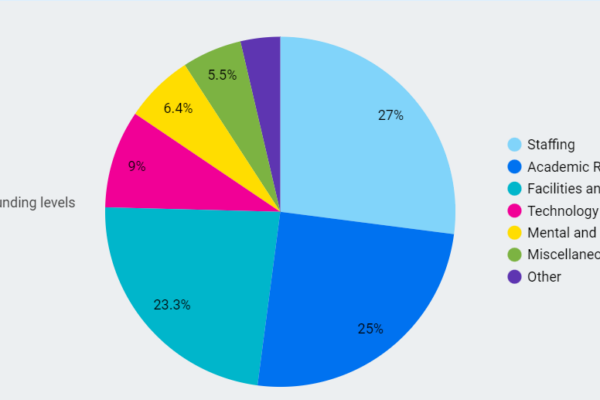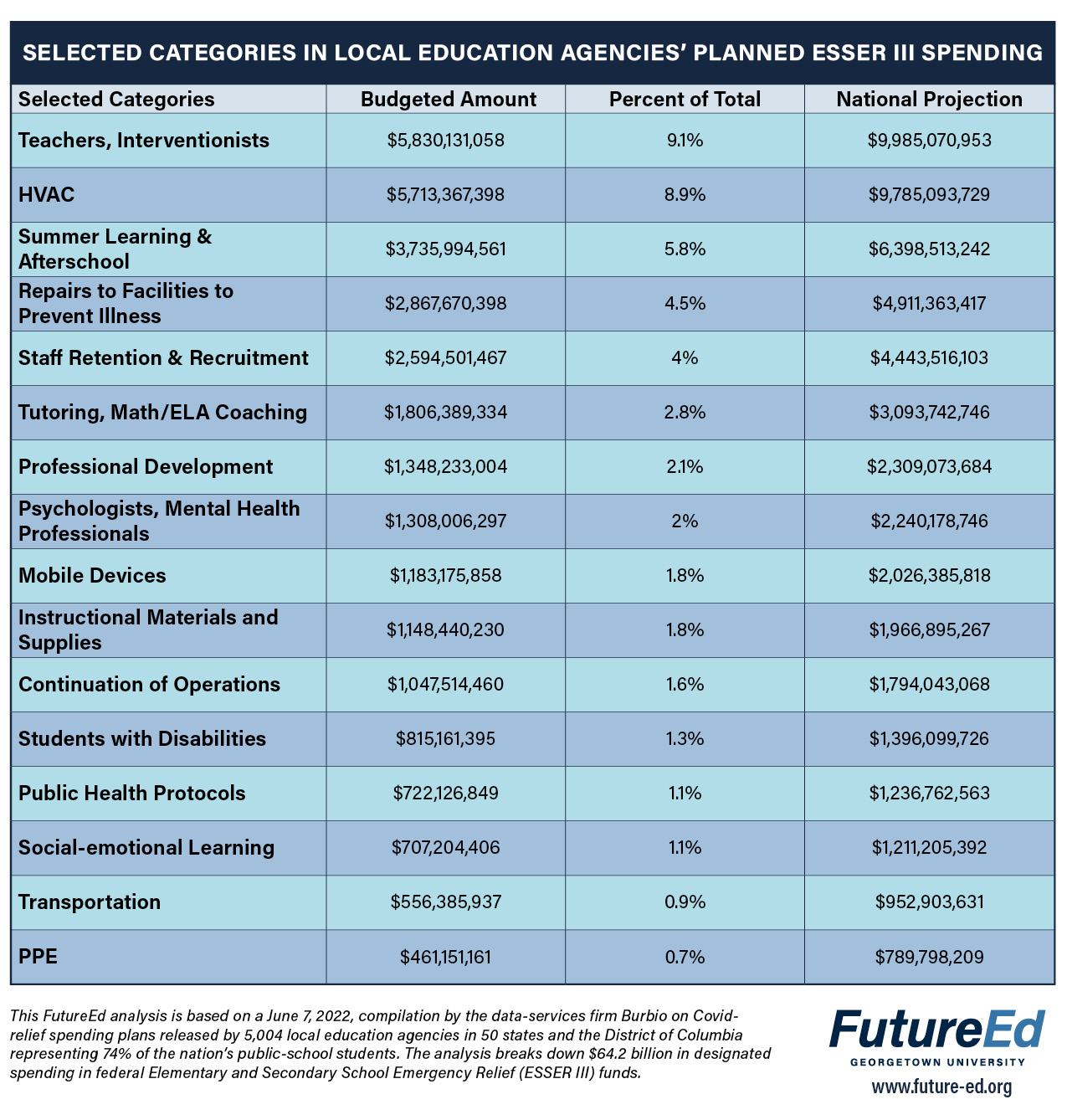More than a year after Congress approved $122 billion in Covid-relief aid for elementary and secondary education through the American Rescue Plan, school districts and charter organizations have targeted their spending on three priorities: academic recovery, staffing, and school facilities and operations, a FutureEd analysis shows.
The analysis, the first to detail the way relief money is flowing through local education agencies, examines spending plans from 5,004 school districts and charter organizations educating 74 percent of the nation’s public-school students. The plans, compiled by the data-services firm Burbio, account for $83 billion in federal Elementary and Secondary School Emergency Relief (ESSER III) funds, but local education authorities have specified a dollar figure for only about $64.2 billion of that sum. FutureEd broke down the designated spending into seven major categories and a number of subcategories.
The spending trends suggest that localities could spend nearly $30 billion in ESSER III funds on staffing, $27 billion on academic recovery, and nearly $26 billion on school facilities and operations by the September 2024 deadline for committing the money.
Rural and suburban students are slightly underrepresented in the sample, and English language learners and low-income students are slightly overrepresented. Fewer than 10 percent of the school districts in Kansas, Michigan, Minnesota, Montana, Nebraska, New Jersey, North Dakota, Vermont, Washington, and Wisconsin are represented.
The Burbio sample nonetheless largely reflects the geographic and demographic diversity of the nation’s public-school students, based on National Center for Education Statistics data, suggesting that the spending trends in the sample are nationally representative and can with some confidence predict how the nation’s education agencies are likely to spend ESSER III monies.
All districts and charter organizations were required to submit plans to state education agencies detailing how the federal aid would be spent. More than 750 districts included no dollar figures but detailed their priorities, largely accounting for why $19 billion of the $83 billion is not included in the analysis. Of the districts that have outlined specific dollar amounts, more than 90 percent of their allotments are committed. Some provided overall amounts for major categories such as academic recovery or staffing; many others offered specific dollar figures for how they plan to allot their funds. Districts in Tennessee and a few districts elsewhere include spending from earlier ESSER funding rounds in their totals.
Local education agencies have earmarked the most resources for staffing, a change from earlier analyses when academic recovery received a bigger share of the designated funding. School districts and charter organizations plan to invest heavily in teachers and other staff to aid the academic recovery. Roughly $17.3 billion or 27 percent of the spending in the analysis will go toward staffing, with a third of that or $5.8 billion for the category that includes teachers, academic interventionists and guidance counselors. Given shortages of teachers and other staff in some parts of the country, some districts are struggling to hire the staff they need.
About $2.6 billion will support teacher recruitment and retention efforts, and another $1.3 billion is dedicated for professional development. Districts and charters are spending $1.3 billion on bringing additional psychologists and other mental health support into schools.
[Read More: How Local Educators Plan to Spend Billions in Covid-Relief Aid]
Academic recovery represents about $16 billion or a quarter of the $64 billion captured in the Burbio sample. School districts and charters have a total of $110 billion in ESSER III money to spend, with another $12 billion allotted to state education agencies.
charters have a total of $110 billion in ESSER III money to spend, with another $12 billion allotted to state education agencies.
Summer learning and afterschool programs make up nearly a quarter of the academic recovery spending, with about $3.7 billion planned. That number could be expected to grow to $6.3 billion as districts plan for spending for the entire ESSER appropriation. Tutoring and coaching for math and English language skills account for another $1.8 billion, which could eventually reach $3 billion if trends hold true. Many districts set aside additional money for staffing these programs.
Instructional materials are also a priority, making up about $1.1 billion, and spending planned for students with disabilities follows behind with $815 million. FutureEd found in a previous analysis that many under-resourced school districts are planning to use Covid-relief funds to replace outdated instructional materials.
Read More: How District Poverty Levels Influence Covid-Relief Spending
The scale of spending on academic interventions isn’t surprising, given the substantial learning deficits that emerged during the pandemic and that, in response, the American Rescue Plan requires local agencies to use at least 20 percent of their ESSER III allotment to address learning loss.
Facilities and operations are another major spending category, representing nearly a quarter of the designated spending, nearly $15 billion. By far the largest priority in this category is upgrading heating, ventilation and air conditioning systems, with nearly $5.7 billion earmarked for these projects, or about 38 percent of the facilities and operations spending. If trends continue, the total for this category could reach $9.8 billion.
Another $2.8 billion is set aside for “repairs that prevent illness,” a priority that includes lead abatement, removing mold and mildew, or replacing leaking roofs. Operational priorities include plans for spending $461 million for PPE and $556 million for transportation costs.
As with instructional materials, we found that a large percentage of under-resourced school districts are investing in facilities projects, seemingly to compensate for years of deferred capital improvements.
Technology priorities, such as mobile devices and connectivity, account for $5.8 billion or about 9 percent of the designated funding in our analysis, while efforts to address students’ mental and physical health, such as social-emotional learning and public health protocols, add up to nearly $4 billion, or about 6.4 percent of the total. A final $3.5 billion is committed to various financial needs, such as grant administration and keeping payroll and school operations going during the pandemic.
Listen to the Podcast: What are Schools Doing With Their Covid-Relief Dollars
Graphics by Merry Alderman Design



